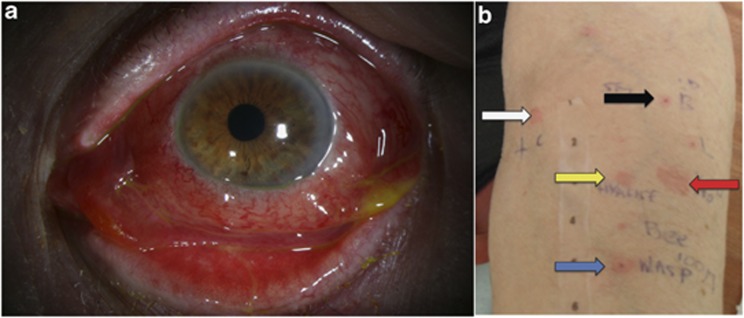Sir,
We report two cases of hyaluronidase hypersensitivity and discuss why it should be used with caution in patients with a known allergy to insect bites or stings.
Case report
Case 1 An 83-year-old female known to develop large, localised reactions to insect bites underwent uncomplicated cataract surgery to the left eye, having had previous routine cataract surgery in the right. Sub-Tenon anaesthesia augmented by hyaluronidase was used in both operations. Two days following surgery to the left eye, she presented with a presumed localised allergic reaction characterised by grossly inflamed eyelids, conjunctival injection, and chemosis (Figure 1a). Inflammation settled over 4 weeks with intensive topical corticosteroids. Final corrected acuity was 6/5. The patient was referred for allergy testing. Skin prick test to hyaluronidase was positive.
Figure 1.
Patient 1: initial post-operative appearances with gross conjunctival injection and chemosis but no significant intraocular inflammation (a). Photograph of allergy testing on forearm of Patient 2 (b). A positive result to hyaluronidase for the skin prick (yellow arrow) and intradermal tests (red arrow) is seen, compared with a negative result (black arrow) for bupivacaine. A negative result to lidocaine (L) is seen below this. There was a positive result to wasp venom (blue arrow). A positive histamine control is also seen (white arrow).
Case 2 A 76-year-old female with known anaphylaxis to wasp stings underwent an emergency therapeutic penetrating keratoplasty for recalcitrant fungal keratitis. Hyaluronidase was used in the regional anaesthesia block. As with case 1, hyaluronidase had been used in previous anaesthetics. Immediately after surgery, the patient became hypotensive and developed a diffuse erythematous maculopapular rash. She recovered following resuscitation with intramuscular adrenaline and intravenous chlorpheniramine and hydrocortisone. Intradermal skin allergen testing was positive to hyaluronidase and wasp venom (Figure 1b).
Comment
Hyaluronidase is found in the venom and saliva of several stinging or biting insects to facilitate the movement of cytotoxic or neurotoxic agents through the recipient's tissue.1 It is often identified as the causative allergen in patients who develop a hypersensitivity reaction to either an insect bite or sting.1 Because of a degree of homology in the hyaluronidase molecule between species, there is a risk of cross allergenicity with hyaluronidase used in regional anaesthesia and should be used with caution in patients with a known allergy to insect bites or stings. This should especially be the case when a patient has had prior exposure from previous anaesthesia and has undergone sensitisation to the molecule.2
Although rare, hyaluronidase hypersensitivity may lead to significant visual impairment.3 Clinicians should be aware of this potential complication and risk of cross-reactivity with insect bites or stings.
The authors declare no conflict of interest.
References
- Muller UR. Hymenoptera venom proteins and peptides for diagnosis and treatment of venom allergic patients. Inflamm Allergy Drug Targets. 2011;10:420–428. doi: 10.2174/187152811797200704. [DOI] [PubMed] [Google Scholar]
- Adams L. Adjuvants to local anaesthesia in ophthalmic surgery. Br J Ophthalmol. 2011;95:1345–1349. doi: 10.1136/bjo.2010.188789. [DOI] [PubMed] [Google Scholar]
- Ahluwalia HS, Lukaris A, Lane CM. Delayed allergic reaction to hyaluronidase: a rare sequel to cataract surgery. Eye. 2003;17:263–2666. doi: 10.1038/sj.eye.6700243. [DOI] [PubMed] [Google Scholar]



